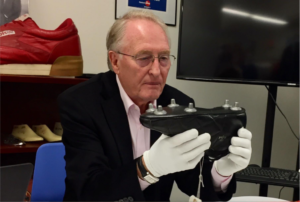Renowned Japanese contemporary artist Takashi Murakami has been known for his colorful, large-scale works that blend traditional Japanese art with modern pop culture. However, in his latest exhibition, Murakami pushes the boundaries of art even further by embracing cutting-edge technology, specifically artificial intelligence (AI), to recreate ancient Japanese paintings. This mix of old-world tradition with new-age technology reflects not only Murakami’s ability to evolve but also a deeper exploration of cultural heritage and the ways in which art can be preserved and reinterpreted through modern tools.
Murakami’s career has been marked by a seamless fusion of tradition and innovation. His work, which is often infused with bright colors and iconic motifs like smiling flowers and cartoonish faces, draws heavily from both Japanese classical art and Western pop culture. Murakami has made his mark by reimagining and recontextualizing ancient motifs and traditional techniques for a global, contemporary audience.
His style, known as superflat, combines elements of both Japanese art history and contemporary visual culture. Drawing inspiration from traditional Japanese ukiyo-e woodblock prints and Japanese folding screens, Murakami’s vibrant, dynamic works create a bridge between the past and the future. His love for Japanese culture, particularly the aesthetic traditions of Nihonga (Japanese-style painting), is evident in his reinterpretations of classical motifs and his ongoing exploration of how Japanese art history can be integrated with global contemporary art movements.
Despite his modern approach, Murakami has always maintained a strong connection to his heritage. In fact, much of his work explores Japan’s complex relationship with tradition and modernity, often highlighting the tensions between preserving the old and embracing the new. This duality between the traditional and the cutting-edge becomes central to understanding Murakami’s latest creative endeavor, where he employs AI to reconstruct and reimagine ancient works of art.
Murakami’s decision to use AI as a medium for creating ancient Japanese paintings stems from his desire to preserve and breathe new life into traditional art. As he explains, AI offers a unique opportunity to reinterpret art forms that may otherwise be lost to time or inaccessible to future generations. By working with AI technology, Murakami can draw on the vast wealth of data available to recreate artworks that adhere to the rules and styles of classical Japanese painting—while introducing a new level of interpretation that traditional methods might not permit.
Through AI, Murakami has been able to train algorithms using thousands of historical paintings from Japan’s Edo period and earlier, which he has digitized and processed. This allows the AI to understand and reproduce the distinctive features of ancient Japanese painting techniques, including the use of bold brushstrokes, delicate shading, and specific iconography. The resulting images are not simple replicas, but reimaginings that combine elements of traditional techniques with the novel possibilities offered by AI.
The underlying idea behind this project is more philosophical than purely technological. Murakami uses AI not just as a tool for artistic expression but as a way to question and explore how heritage is preserved and how it can be transformed in the digital age. Through this work, Murakami asks whether the use of AI could act as a form of artistic preservation—one that retains the authenticity of traditional art while simultaneously offering something new, accessible, and progressive.
Art preservation has always been a significant concern for museums, curators, and artists alike. Many priceless works of art, particularly those created centuries ago, are vulnerable to time and environmental conditions. As time passes, the colors fade, the canvases degrade, and the fine details become less discernible. For traditional artworks, this often means that the true essence of the piece becomes difficult to appreciate, let alone preserve for future generations.
In this context, AI offers a potential solution. By digitizing existing works of art and training AI algorithms to analyze and recreate them, Murakami believes that these masterpieces can be safeguarded in a digital realm that allows them to exist indefinitely. Digital reproduction can also allow future generations of artists and scholars to study these works in unprecedented detail, ensuring that the intricacies and subtleties of ancient techniques are not lost.
What makes Murakami’s use of AI particularly intriguing is that he is not merely digitizing the works but actively reimagining them. The use of AI enables him to blend the traditional techniques of ancient painters with the vast creative possibilities of the digital medium. The resulting pieces are not faithful copies, but artistic interpretations that retain the essence of the originals while offering an entirely new experience. This process highlights how AI can be used to rethink and re-envision the past, presenting it in a way that feels fresh and relevant in the present day.
One of the most fascinating aspects of Murakami’s use of AI is the way in which he describes the technology as a collaborative partner rather than simply a tool. In his interviews, Murakami has likened the relationship between the artist and AI to that of a dialogue or partnership. Just as an artist might collaborate with a designer, musician, or other artist, Murakami views AI as a way to extend his creative process and open new possibilities that wouldn’t have been possible through traditional methods alone.
Through the process of training AI on historical art data, Murakami has allowed the machine to learn and understand the patterns, themes, and cultural context behind ancient works of art. However, rather than simply producing predictable or formulaic results, the machine’s interpretations of these historical works come with an element of unpredictability—an outcome that reflects the nuances and peculiarities of the AI’s algorithm. This unpredictable, almost organic element adds a layer of mystery to Murakami’s new works, making them more dynamic and less rigidly tied to the constraints of traditional painting.
Murakami’s exhibition featuring AI-created works of ancient Japanese paintings brings together the old and the new in a stunning visual display. On one hand, viewers are presented with works that are inspired by centuries-old techniques and Japanese visual culture. On the other hand, the exhibition introduces a fresh, cutting-edge approach to art, one that draws heavily from artificial intelligence and machine learning.
The works in the exhibition evoke the spirit of traditional Japanese paintings, such as ukiyo-e, but they also reveal a futuristic sensibility. Murakami has often stated that his goal is to not only preserve these art forms but to also push the boundaries of what art can be in the digital age. In doing so, he seeks to demonstrate how the past and future are intertwined, and how AI can provide a means for artistic growth rather than diminish the value of human creativity.
This exhibition also raises important questions about the role of technology in the world of fine art. As AI continues to evolve and influence the creative industries, Murakami’s work provides a thought-provoking commentary on how artists can engage with technology without losing touch with tradition. His efforts challenge the notion that technology and craftsmanship are mutually exclusive, presenting a harmonious blend of the two.
Murakami’s experimentation with AI also carries deep cultural significance, particularly in the context of Japan’s rich artistic history. Japan has a long and proud tradition of artistic excellence, with periods like the Edo and Meiji eras producing some of the world’s most celebrated works. For Murakami, this exhibition is a way to honor and preserve that legacy while also inviting a contemporary audience to reimagine what those works could be in the digital age.
By using AI to reinterpret these ancient paintings, Murakami brings to light the fluidity of artistic expression and the way art can evolve with time. In this sense, Murakami’s work speaks to the dynamic relationship between heritage and innovation—two forces that are often seen as opposing yet are deeply intertwined in the history of Japanese art.
In his latest exhibition, Takashi Murakami has embarked on a bold new venture, blending ancient Japanese art with artificial intelligence in a way that challenges our perceptions of both. Through his use of AI, Murakami not only preserves the beauty and intricacies of traditional painting but also opens up new ways of reinterpreting and engaging with the past. This fusion of old-world craftsmanship and cutting-edge technology reflects Murakami’s unique ability to push the boundaries of art while maintaining a deep connection to his cultural heritage.
In doing so, Murakami is not just creating a new body of work but is also sparking a conversation about the future of art, the role of technology in creativity, and the ever-changing nature of artistic expression. His use of AI is a bold statement about how the past and future can coexist and how technology can serve as a partner in the ongoing evolution of art and culture.
No comments yet.








